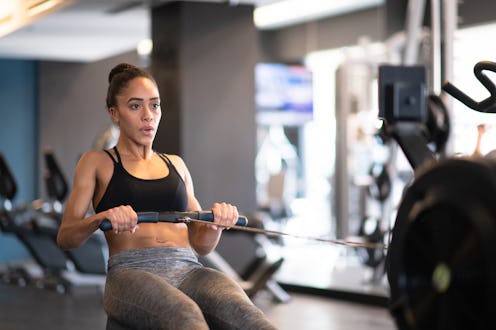Fitness
All Of The Muscles You Use In A Rowing Workout
It involves your entire body.

If you typically walk right past the rowing machine at the gym, you might want to consider popping on it next time. Not only is rowing an excellent cardio workout, but it also hits a surprising number of muscle groups, making it a great choice for your strength training routine, too.
While the rowing machine — also called an ergometer — might look complicated, it’s actually incredibly user-friendly, says Caley Crawford, NASM CPT, a certified personal trainer and director of education for Row House. All you have to do is sit down, strap your feet into the footholds, and then pull back on the handles as you use your legs to push away from the flywheel, aka the part of the machine that spins to simulate rowing through water.
According to Chris Chang, a personal trainer and director of exercise science and programming at rowing company Egratta, this rowing motion engages the muscles of your legs, body, and arms all at once for a compound strength training movement. “It’s like combining a leg press, kettlebell swing, and an upper body row all into one cardio-packed exercise,” he tells Bustle.
If you want to go easy on the cardio, you can row slow and steady for a gentler workout that strengthens muscles as you promote flexibility and joint health, Crawford says. Or row faster and longer for a cardio workout that’ll improve your endurance and leave you sore the next day. Either way you do it, these are all the muscles rowing works, according to trainers.
All The Muscles Rowing Works
According to Crawford, rowing recruits over 85% of your body’s muscles, primarily hitting the legs, arms, and core.
Core
To really work your muscles when rowing it’s important to focus on good form, so start by checking out the video above to see how to do a proper rowing stroke. You’ll notice that you’re supposed to lean back a bit at the end of the movement — this is called the finish, Crawford says, and it’s the part that engages your abdominal muscles.
You’ll also engage your core, as well as your hip flexors and serratus anterior muscles, as you return forward in the stroke. This motion helps compress your body like a swing, Chang explains, which helps you wind up potential energy for the next stroke.
Quads And Hamstrings
Rowing is also considered a major leg exercise, says Jane Gumley, a personal trainer and head coach of the University of Victoria women’s rowing team. “Your power in rowing is driven by your big leg muscles,” she tells Bustle, which includes the quads, calves, and hamstrings.
This is because you bend your knees and then push back on the footholds to propel your body backward. “Think of all the muscles you activate while doing a squat,” Gumley adds. “That’s what rowing does over an extended period of time.”
Glutes
Your hips hinge open during the stroke as well, which Chang says engages the glute muscles in the same way a deadlift would. That’s why you’re bound to feel sore in your lower body the day after rowing — not just in your arms.
Lats
Rowing also works the latissimus dorsi muscle located on your back. “In the rowing stroke, after powering through your legs, you set yourself up to be in a strong position to pull with your back and lats,” Gumley says. The goal is to squeeze your shoulder blades together as your arms pull back on the handles.
Just be sure to use proper form to make the most of each stroke. “People often get the second half of the stroke wrong by scooting in before their arms are extended out again,” Crawford says. “To ensure proper technique and sequence, think legs, core, arms; arms, core, legs.”
Biceps And Deltoids
The deltoids, located on the top of each shoulder, engage as you row. And then there are your bicep muscles, which Chang says contribute to about 10% of the total force of your row as you draw the handles in toward your sternum. Talk about a full-body strength training workout.
Studies referenced:
Ian Gee, T., Caplan, N., Christian Gibbon, K., Howatson, G., & Grant Thompson, K. (2016). Investigating the Effects of Typical Rowing Strength Training Practices on Strength and Power Development and 2,000 m Rowing Performance. Journal of Human Kinetics, 50, 167–177. https://doi.org/10.1515/hukin-2015-0153.
Kang SR, Yu CH, Han KS, Kwon TK. Comparative analysis of basal physical fitness and muscle function in relation to muscle balance pattern using rowing machines. Bio-Medical Materials and Engineering. 2014;24(6):2425-35. doi: 10.3233/BME-141056. PMID: 25226943.
Experts:
Caley Crawford, NASM CPT, certified personal trainer and director of education for Row House
Chris Chang, personal trainer and director of exercise science and programming at rowing company Egratta
Jane Gumley, personal trainer and head coach of the University of Victoria women’s rowing team
This article was originally published on